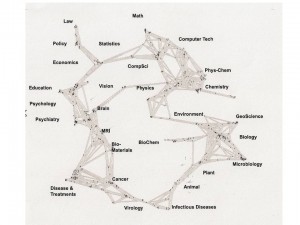Phi Beta Iota: Most serious analysts now understand Citation Analytics 101. It's time to move to Citation Analytics 202, and there is no better way to introduce the art of the possible than by pointing to Kevin W. Boyack, Katy Borner, and Richard Klavans (2007), “Mapping the Structure and Evolution of Chemistry Research (11th International Conference of Scientometrics and Infometrics, pp. 112-123.


There are several take-aways from this article, which is more or less the “coming out” of the Klavens-inspired infometrics field now that he has won his law-suit and has unchallenged access to all Institute of Scientific Information (ISI) access [this was one of the sources we used to win the Burundi Exercise before the Aspin-Brown Commission in 1995].
1. The humanities and the sciences are so far apart as to be on different planets.
2. The various disciplines, even within the sciences, are not collaborating effectively.
3. The sub-disciplines within disciplines are not collaborating effectively.
4. It is now possible to calculate both speed of sharing and impact of money in relation to funding sources and funding recipients.
Bottom line: there is no one place, no one network, no one sponsor, no one anything dedicated to the proposition that all information in all languages and all human minds in all cultures should be able to “connect the dots” irrespective of any traditional boundaries.
Graphic: Web of Fragmented Knowledge
Review (Preliminary): Atlas of Science–Visualizing What We Know
Review: Keeping Abreast of Science and Technology: Technical Intelligence for Business
2002 Klavans (US) Tomorrow’s Hotspots: Identifying Commercial Opportunities from Science
Worth a Look: SciVal from Elsevier
Review: Scholarship in the Digital Age–Information, Infrastructure, and the Internet



